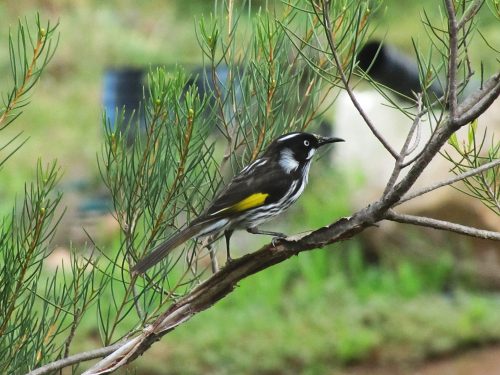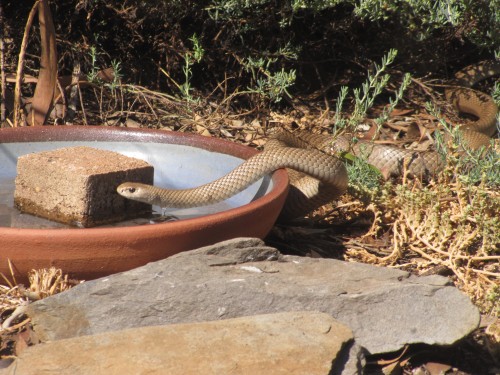Upset New Holland Honeyeaters
Last week my wife and I were sitting on our back veranda having lunch. We were enjoying a brief burst of spring weather and the sun was most welcome. We have had a long stretch of very cold, showery, wintery weather for well over a month, so the change was very much appreciated.
I often have my binoculars at the ready in case I want to check out any of the many birds we see in our garden. Sometimes I even have my camera at the ready, too. As we were enjoying a cup of tea after lunch, a flock of about a dozen New Holland Honeyeaters set up a terrible racket in the bushes about ten metres from where we were sitting. I immediately thought that their warning calls meant that there was a bird of prey in the sky overhead, or else it was in the trees nearby.
On looking around, and checking the sky, I could not see any evidence of anything they could be getting upset over. All of the honeyeaters kept calling and fluttering around, obviously quite agitated by something on the ground. I cautiously walked towards them. They took no notice of my presence and kept calling loudly.
Snake!
A metre long Eastern Brown Snake was trying to stay inconspicuous in the shadows, but I caught a glimpse of it as it made its escape into the undergrowth – and away from the keen eyes of the resident honeyeaters. I slowly made my retreat, intent on not getting too close to one of the world’s deadliest reptiles right there in our garden.
Every summer we usually see one or two Brown Snakes in our garden, on our five-acre property, or crossing the road leading to our home. We usually give them a wide berth when we see one and never try to get too close. They don’t bother us and we don’t bother them. I prefer to let them be because not only are they protected under our laws, they also do us the service of keeping mice and rat numbers down to a manageable level. My only concern was that this was rather early in spring for our first sighting; summer won’t start until December.
I guess that we will have to keep an eye out for them in the coming months. Proceed with caution.
Further reading:
- Bird baths are not just for birds – this post includes photos of a Brown Snake at one of our bird baths,
- Brown Snakes and Woodswallows
- Beautiful birds, leaping lizards and slithering snakes
Another unusual visitor to our bird bath
In recent times I have written about the behaviour of various species of birds at the bird baths we have in our garden. The birds give us many hours of entertainment as they come to drink and bathe. The very hot weather we have been having this summer helps to encourage their frequent visits.
I also wrote recently about some unusual visitors to the bird baths, a Stumpy Tail Lizard and a Red Fox.
A few days ago I was alerted to the alarm calls of a flock of New Holland Honeyeaters near the bird bath. I quietly went to have a look. The NHHEs were soon joined by several Singing Honeyeaters and a family of White Browed Babblers. All were calling madly and looking at the ground near a bush.
I waited for a few moments, fully expecting a Brown Snake (highly venomous) to emerge from the undergrowth. I had my camera at the ready and my feet ready to take off if a hasty retreat was in order.
To my great relief it was only a Blue Tongue Lizard. With the stripes on the back and tail, and a thin, long snake-like tail we have often been fooled into thinking we have a Tiger Snake (also quite venomous) in the garden. (They actually look nothing like a Tiger Snake; it’s the stripes that catch you by surprise every time.)
The new visitor didn’t wait to have a drink. A slight movement from me sent it slithering – almost snake-like – into the undergrowth again.
Related articles:
- Some unusual visitors to our birth bath – with photos.
- Time for a bath – with more photos
Updated November 2103


